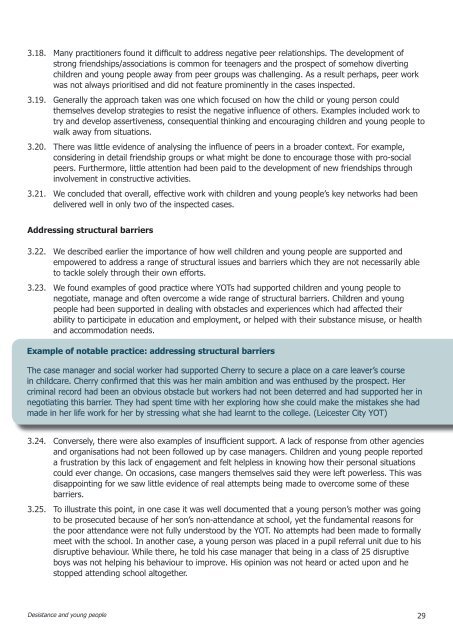Desistance and young people
Desistance_and_young_people
Desistance_and_young_people
Create successful ePaper yourself
Turn your PDF publications into a flip-book with our unique Google optimized e-Paper software.
3.18. Many practitioners found it difficult to address negative peer relationships. The development of<br />
strong friendships/associations is common for teenagers <strong>and</strong> the prospect of somehow diverting<br />
children <strong>and</strong> <strong>young</strong> <strong>people</strong> away from peer groups was challenging. As a result perhaps, peer work<br />
was not always prioritised <strong>and</strong> did not feature prominently in the cases inspected.<br />
3.19. Generally the approach taken was one which focused on how the child or <strong>young</strong> person could<br />
themselves develop strategies to resist the negative influence of others. Examples included work to<br />
try <strong>and</strong> develop assertiveness, consequential thinking <strong>and</strong> encouraging children <strong>and</strong> <strong>young</strong> <strong>people</strong> to<br />
walk away from situations.<br />
3.20. There was little evidence of analysing the influence of peers in a broader context. For example,<br />
considering in detail friendship groups or what might be done to encourage those with pro-social<br />
peers. Furthermore, little attention had been paid to the development of new friendships through<br />
involvement in constructive activities.<br />
3.21. We concluded that overall, effective work with children <strong>and</strong> <strong>young</strong> <strong>people</strong>’s key networks had been<br />
delivered well in only two of the inspected cases.<br />
Addressing structural barriers<br />
3.22. We described earlier the importance of how well children <strong>and</strong> <strong>young</strong> <strong>people</strong> are supported <strong>and</strong><br />
empowered to address a range of structural issues <strong>and</strong> barriers which they are not necessarily able<br />
to tackle solely through their own efforts.<br />
3.23. We found examples of good practice where YOTs had supported children <strong>and</strong> <strong>young</strong> <strong>people</strong> to<br />
negotiate, manage <strong>and</strong> often overcome a wide range of structural barriers. Children <strong>and</strong> <strong>young</strong><br />
<strong>people</strong> had been supported in dealing with obstacles <strong>and</strong> experiences which had affected their<br />
ability to participate in education <strong>and</strong> employment, or helped with their substance misuse, or health<br />
<strong>and</strong> accommodation needs.<br />
Example of notable practice: addressing structural barriers<br />
The case manager <strong>and</strong> social worker had supported Cherry to secure a place on a care leaver’s course<br />
in childcare. Cherry confirmed that this was her main ambition <strong>and</strong> was enthused by the prospect. Her<br />
criminal record had been an obvious obstacle but workers had not been deterred <strong>and</strong> had supported her in<br />
negotiating this barrier. They had spent time with her exploring how she could make the mistakes she had<br />
made in her life work for her by stressing what she had learnt to the college. (Leicester City YOT)<br />
3.24. Conversely, there were also examples of insufficient support. A lack of response from other agencies<br />
<strong>and</strong> organisations had not been followed up by case managers. Children <strong>and</strong> <strong>young</strong> <strong>people</strong> reported<br />
a frustration by this lack of engagement <strong>and</strong> felt helpless in knowing how their personal situations<br />
could ever change. On occasions, case mangers themselves said they were left powerless. This was<br />
disappointing for we saw little evidence of real attempts being made to overcome some of these<br />
barriers.<br />
3.25. To illustrate this point, in one case it was well documented that a <strong>young</strong> person’s mother was going<br />
to be prosecuted because of her son’s non-attendance at school, yet the fundamental reasons for<br />
the poor attendance were not fully understood by the YOT. No attempts had been made to formally<br />
meet with the school. In another case, a <strong>young</strong> person was placed in a pupil referral unit due to his<br />
disruptive behaviour. While there, he told his case manager that being in a class of 25 disruptive<br />
boys was not helping his behaviour to improve. His opinion was not heard or acted upon <strong>and</strong> he<br />
stopped attending school altogether.<br />
<strong>Desistance</strong> <strong>and</strong> <strong>young</strong> <strong>people</strong><br />
29


